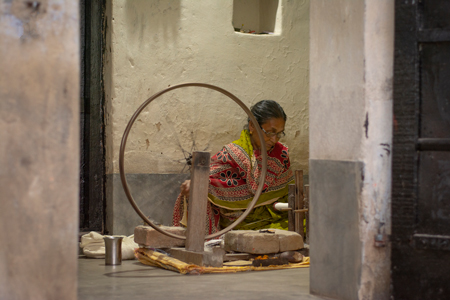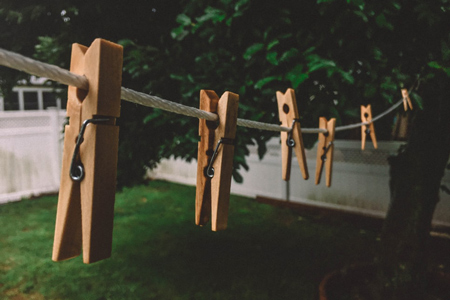
Wonder What Can Be More Ethical & Environment Friendly Than Fabrics Made With Just Natural Fibre Like Cotton & Silk. It's The Indian Khadi, Which Has Been Handspun & Handwoven From The Natural Fibres, Making The Process Of Making The Fabric Also Ethical & Sustainable.
Fibre is the fundamental unit of textile. Natural fibres are collected & processed through a series of procedures in order to clean and bundle together. These clean fibres are then spun into yarns either through machines or manually, which are later used to produce handwoven cotton fabric. In the manual process, the fibres are spun on the spinning wheel or charkha to produce handspun yarn. This handspun yarn may then be used to weave fabric on a handloom weaving machine.
The tabletop or floor charkha is one of the oldest known forms of the spinning wheel. The wheel is turned by one hand, while the yarn is spun off the tip of the spindle with the other. The direction in which the yarn is spun is called twist. Handspun single plies are spun with a Z-twist, and plying is done with an S-twist. In this way, the opposite-direction plying keeps the spun yarn from untwisting itself. Weaving with handspun yarn produces the khadi material.
IMPACT ON INDIA
The handspun handwoven fabric has been a huge part of India and was a major part of the nation's economic strength before colonialism. Mahatma Gandhi began promoting the spinning of khadi for rural self-employment and self-reliance during the Swadeshi movement (Khadi movement).
However, today, the Khadi industry is far from flourishing. There is a significant decline in the number of India's handloom weavers due to a decrease in its demand. Anuprerna is working towards the goal of bridging the gap in demand by creating awareness about Indian Khadi clothes which would encourage the weavers to preserve this craft.
VARIETY IN KHADI FABRICS
1. Khadi Cotton Fabric- This is a handspun cotton fabric which means it is made by hand weaving with handspun yarn procured from cotton.
Khadi yarn is commonly around a thicker 20 counts and is great for upholstery or homeware. For apparels, yarn is finer, with 60-80 counts being perfect for shirts and dresses that need some structure and crispness. Whereas an even finer variety of 100 and 120 counts or even higher are suitable for summer wears like dresses and tunics.
The 500 or 1000 count Khadi is a variety that was once renowned as the Finest Khadi and was of very superior quality. Today, it is very rare to find. It is very difficult to spin and weave due to how delicate and fine the yarns. It requires the right temperature, humidity and a very skilled weaver to be produced.
2. Khadi Silk Fabric- This fabric has two subtypes:
The first is pure Khadi silk which means the fabric is woven from completely silk yarn like our pure mulberry silk. It is known to be one of the finest as well as the most popular variety of silk. To learn more about Mulberry Silk, visit the craft page here.
The second type includes the blending of several yarns. Khadi Silk with a mixture of other yarns produces varieties like- Matka Khadi Silk, Tussar Khadi Silk. & Ketya Khadi Silk. The details for each of these crafts can be found on our website through the links here- Matka Peace Silk, Ketya Peace Silk, Tussar Silk.
Weaving Khadi fabric is challenging due to certain properties characteristic of handspun yarn. Since the yarn is irregular in thickness, dyeing is inconsistent. Khadi is also prone to shrinking after wash. It also tends to be expensive compared to mill spun & power loom woven fabric due to the competition in the market from the latter.
However, the benefits definitely outweigh the challenges of Khadi production. With experienced weavers, it is possible to produce more uniform yarns. Anuprerna has been working with Khadi weavers across various clusters in Bengal for over 30+ years and have been producing finer Khadi fabrics.
BENEFITS IN WEARING KHADI
- Indian Khadi clothes can be worn in any weather. It's warm in the winters and cool in the summers.
- Khadi material is a body-friendly fabric that does not cause any allergies or irritations, unlike other synthetic fabrics.
- Khadi dyes and weaves are done by hand. Each khadi pure product is different and has a very peculiar style and unique finish.
- The loom used in making khadi handspun cotton fabric combines the threads to allow maximum air to permeate, which is very soothing, especially in summers.
- Khadi products are highly durable and long-lasting
- Due to the nature of the craft where the charkha and looms can be easily set up in small space, it can provide employment and hence food to the rural population
- The making of khadi is eco-friendly, as it does not rely on any electric unit and manufacturing processes and thus has a low carbon footprint. At Anuprerna, the dyed handspun handwoven fabric is made from hand dyed yarn.
- The characteristic feature of a Khadi handmade cloth is its imperfections and irregularities.
CARE GUIDE OF KHADI

Source: Anuperna.com
TKhadi fabric is quite easy to maintain as it needs to be hand washed and ironed for a fresh, refined look. It is prone to shrinking to some extent even in the case of pre-shrunk fabrics but this can be easily fixed by ironing later. For washing, it is advised that strong chemical detergents are not used.
With the increasing awareness and appreciation for Khadi hand woven textiles, more and more designers are incorporating the fabric in their design. There is a potential for an increase in demand for the finer variety of Khadi as well. We can now see them draped in a plethora of silhouettes, both western and ethnic.
Khadi has found its use in several categories and is already being used to make apparel, accessories and upholstery.
